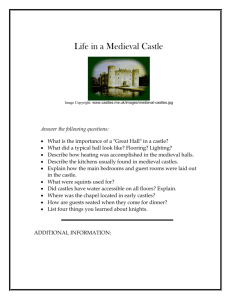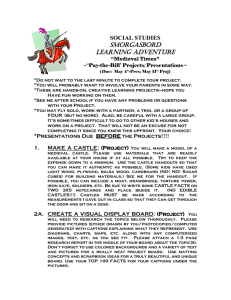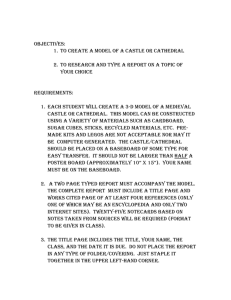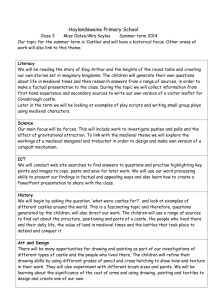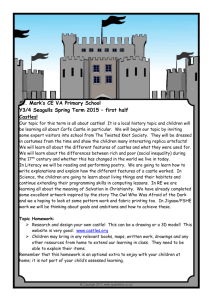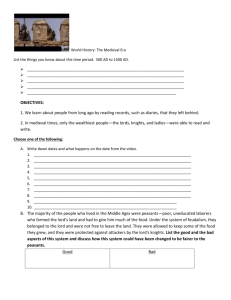Second Level Learning Journey People of Medieval Scotland Introduction
advertisement
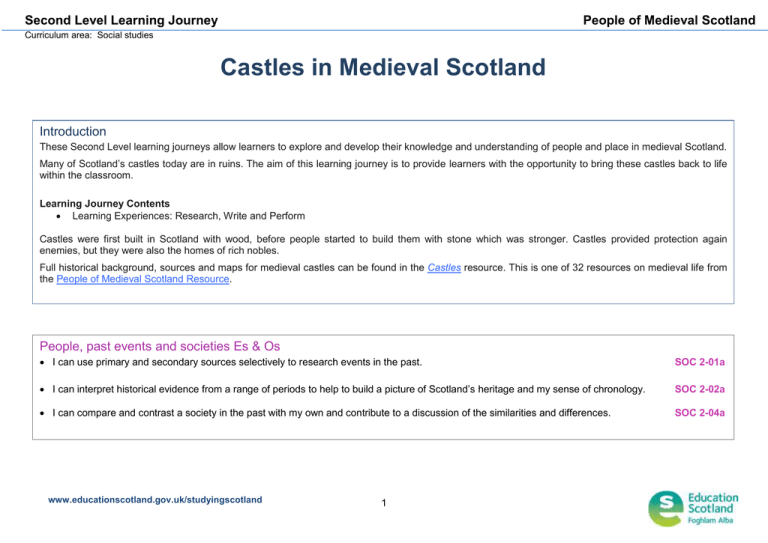
Second Level Learning Journey People of Medieval Scotland Curriculum area: Social studies Castles in Medieval Scotland Introduction v These Second Level learning journeys allow learners to explore and develop their knowledge and understanding of people and place in medieval Scotland. Many of Scotland’s castles today are in ruins. The aim of this learning journey is to provide learners with the opportunity to bring these castles back to life within the classroom. Learning Journey Contents Learning Experiences: Research, Write and Perform Castles were first built in Scotland with wood, before people started to build them with stone which was stronger. Castles provided protection again enemies, but they were also the homes of rich nobles. Full historical background, sources and maps for medieval castles can be found in the Castles resource. This is one of 32 resources on medieval life from the People of Medieval Scotland Resource. People, past events and societies Es & Os I can use primary and secondary sources selectively to research events in the past. SOC 2-01a I can interpret historical evidence from a range of periods to help to build a picture of Scotland’s heritage and my sense of chronology. SOC 2-02a I can compare and contrast a society in the past with my own and contribute to a discussion of the similarities and differences. SOC 2-04a I can discuss why people and events from a particular time in the past were important, placing them within a historical sequence. www.educationscotland.gov.uk/studyingscotland 1 SOC 2-06a Second Level Learning Journey People of Medieval Scotland Curriculum area: Social studies Interdisciplinary Opportunities Prior Learning Learners would benefit from: Technologies I can enhance my learning by applying my ICT skills in different learning contexts across the curriculum. TCH 3-04a C Completing the KWL grid based on castles. This would establish their previous knowledge. Pupils list the questions they would like to find answers to by the completion of this series of lessons. Expressive Arts Through observing and recording from my experiences across the curriculum, I can create images and objects which show my awareness and recognition of detail. EXA 2-04a Inspired by a range of stimuli, I can express and communicate my ideas, thoughts and feelings through activities within art and design. EXA 2-05a I can develop and communicate my ideas, demonstrating imagination and presenting at least one possible solution to a design problem. EXA 2-06a Responsibility of All Es & Os: Literacy When I engage with others, I can respond in ways appropriate to my role, show that I value others’ contributions and use these to build on thinking. LIT 2-02a When listening and talking with others for different purposes, I can: – share information, experiences and opinions – explain processes and ideas – identify issues raised and summarise main points or findings – clarify points by asking questions or by asking others to say more. LIT 2-09a I am developing confidence when engaging with others within and beyond my place of learning. I can communicate in a clear, expressive way and I am learning to select and organise resources independently. LIT 2-10a / LIT 3-10a I can make notes, organise them under suitable headings and use them to understand information, develop my thinking, explore problems and create new texts, using my own words as appropriate. LIT 2-15a I can use my notes and other types of writing to help me understand information and ideas, explore problems, make decisions, generate and develop ideas or create new text. I recognise the need to acknowledge my sources and can do this appropriately. LIT 2-25a www.educationscotland.gov.uk/studyingscotland • 2 Second Level Learning Journey People of Medieval Scotland Curriculum area: Social studies Learning Experiences: Research, Write and Perform Introduction Through investigating medieval castles in Scotland, learners will develop a deeper understanding of: Locations of castles. Importance of castles. Purpose of castles. Possible learning opportunities / tasks MAKE A list of their research findings in note form. See supplementary materials for possible learning opportunities / tasks which relate to this learning journey. SAY Feedback to group or class on research findings. KWL grid. WRITE Label the parts of a Scottish medieval castle. Castle features worksheets. Stimulus Comparing castles to modern homes. Encourage learners to make comparisons between modern and medieval societies. Learners can: Use primary and secondary sources independently to discover and build upon their knowledge of medieval castles in Scotland. Apply their knowledge by correctly labelling a medieval castle. Using junk modeling, create a 3D castle which demonstrates their knowledge of the features of a medieval castle. DO Build a 3D model of a Scottish medieval castle. Reflecting on learning Useful resources Key learning Possible evidence Castles and Castle Keeper Payments resources at People of Medieval Scotland. 3D Virtual reconstructions http://www.timeref.com/3dindex.htm Scottish castles map http://www.britainirelandcastles.com/map/Scotl and.html BBC Class Clip 10762 http://www.bbc.co.uk/learningzone/clips/thenormans-motte-and-bailey-castles/10762.html Historic Scotland website www.historic-scotland.gov.uk www.educationscotland.gov.uk/studyingscotland 3 Have learners contributed during all tasks? Have learners been able to label all parts of the castle correctly? Have learners used knowledge learned to create a model of a 3D castle? Have learners completed their KWL Grid? Taking it further Excursions to a Scottish medieval castle to bring their learning to life. A class wall display to show learners’ knowledge of castles. A class medieval banquet. Invite parents, pupils and staff to provide an opportunity to share their learning.
